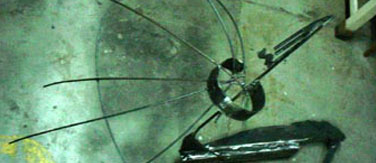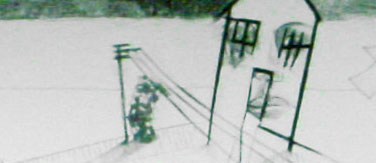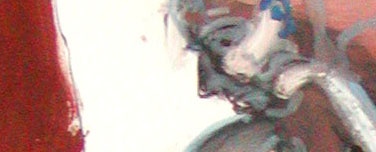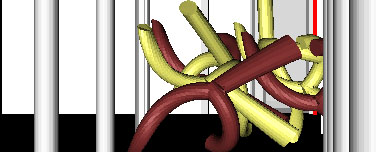|
CREATIVE TECHNOLOGY:
NOTES
TELEMATICS
To facilitate the development of ideas for projects in the area of telematics I have decided to keep these notes as an appendix to my proposals.
Telematics Definition
The combination of telecommunications and computing. Data communications between systems and devices.
Accessed 11/11/04 learnthat.com
My ideas for telematics here
|
 |
Telematics is the English language version of the French word telematique -- coined by Simon Nora and Alain Minc in the book L'informatisation de la Societe (La Documentation Francaise, 1978); translated as The Computerization of Society (MIT Press, 1980). A synopsis of the book by a student in Oregon is posted here
[Accessed 11/11/04] www.globaltelematics.com
-The book link does not exist.
Telematics and telepresence
The notions of telematics and telepresence began to gain importance for interactive media art in the late
1980s.
[Accessed 11/11/04]www.medienkunstnetz.deThis site has an in depth description of the history of telematics, well worth a read
Telematics and telepresence
The notions of telematics and telepresence began to gain importance for interactive media art in the late1980s. Telepresence allows the viewer parallel experiences in three different spaces at once: 1. in the "real" space in which the viewer's body is physically located; 2. per tele-perception in the "virtual, simulated visual space reproducing a fictional or real, remote visual sphere; and 3. per tele-action at the physical location of the "data work or even of a robot controllable over one's movements or equipped with a sensory apparatus over which one can find one's bearings."[17] To a certain extent, this concept-and primarily that of acting or influencing from a distance-is also reflected in interactive media art.[18] Kit Galloway and Sherrie Rabinowitz, who since 1977 have been working under the name Mobile Image, are indubitably pioneers in the field. Their groundbreaking "Hole in Space" project (1980) demonstrated almost all the attributes of telepresence, with one exception: The viewers/users were not represented in virtual reality. However, they do perceive the remote space (tele-perception) and also interact with it (tele-action) or, as the case may be, with the people at the other end of the "hole in space." The installation served in a three-day-long experiment in November 1980 that used
a satellite link to connect in real time one location in Los Angeles with another in New York. Chance passers-by could use the "Hole in Space" to establish visual and acoustic contact with people at the other end of the USA.
Richard Kriesche's "telematic sculptures" are a good example of telematic projects. After examining the significance of background noise in technical or satellite communications in various performances such as "Radio Time" (1988) and "Artsat" (1991), Kriesche collaborated with Peter Gerwin Hoffmann to create "Telesculpture III" (1993). This sculpture consisted of a twenty-four-meter-long section of train track that was transported across the exhibition space by a twenty-meter-long conveyor belt. The track's slow but constant movement towards the wall was triggered by telephone calls received within the scope of a project by Fred Forest.[19] The number and information content of the calls determined whether or not the track would be pushed up against the wall and smash the monitor strapped to its end in the process-the telephone calls therefore initiated a movement directed against another medium. This linkage with thetelephone network gave rise to complex interaction. As the first worldwide information and communications network, the international telephone system supplied "Telesculpture III" with controlling impulses, and overruled the sculpture's spatial boundaries. For the Austrian Pavilion at the 1995 Venice Biennial, Kriesche expanded his concept to produce "Telematic Sculpture 4" (T.S.4), in which a train track is continuously moved by the data streams on the Internet. Each time somebody logged into "T.S.4," the sculpture was temporarily brought to a standstill. The entire volume of data streams, and with them the concrete movement of the sculpture through the pavilion, was displayed on a monitor as status information.
By contrast, the works of Paul Sermon clearly aim at interpersonal, often almost intimate, communication, and are conceptually linked with the "Hole in Space" project of Galloway and Rabinowitz. "Telematic Dreaming" (1992) was Sermon's first project in a series of telematic installations linking two remote locations over blue-box technology and ISDN video conferencing. The "Telematic Dreaming" interface
consisted of a specially equipped double bed allowing its occupant(s) to communicate over gestures and movements with the occupant(s) of an identically equipped bed at the remote location. The use of blue box and ISDN video conferencing made it appear as if the actually far-apart participants were lying together in one virtual double bed. The bed metaphor in particular makes this installation the most intimate of Sermon's telematic works.
We look for the creation of a nonhuman type in whom moral suffering, goodness of heart, affection, and love, those sole corrosive poisons of inexhaustible vital energy, sole interrupters of our powerful bodily electricity, will be abolished ... This nonhuman and mechanical being, constructed for an omnipresent velocity, will be naturally cruel, omniscient,and combative.(2)
- Filippo Tomaso Marinetti
an essay on telematics is available here… ,www.duke.edu
There is a copy of the magazine article based on the above at www.findarticles.com
See the print version to read the full article.
Excellent website for telematics telematic.walkerart.org
THE CHALLENGE:
WE MUST CREATE AT THE SAME SCALE
AS WE CAN DESTROY
1984
If the arts are to take a role in shaping and humanizing emerging technological environments, individuals and arts constituencies must begin to imagine at a much larger scale of creativity.
We must begin to create at the same scale as we can destroy, or else art, and more dangerously the human spirit and imagination, will be rendered decorative and impotent.
If the boundaries between art and life dissolve it will be the result of artists migrating towards a new order of artmaking, abandoning the conventional standards and practices and becoming 'new practitioners' or systems integrators, who produce situations, contexts, and permanent environments or utilities. The 'new practitioners' can begin the process of healing the aesthetic wound that has disfigured the business of Art, and continue the aesthetic quest in more relevant directions.
New creative activities must emerge such as multi-media creative solutions networks, not simply computer networks for Artists, but rather multi-media telecommunications networks with agendas that can engage multi-disciplinary constituencies. This will require the development of new skills and the cultivation of new relationships between the participants. The movement is towards the control of a meaningful context, creating environments not just to support art, but that create the possibility for new scales of creativity across all disciplines and boundaries.
The dark side of the "new world information order" suggests that a new scale aesthetics be created. It will take several years from the time this work begins for creative solutions networks of appropriate number, scale, velocity, and dexterity to evolve to maturity. Consider: co-creating non-imperialistic, multi-cultural or domestic agendas for community or global scale aesthetic endeavors. Consider: the continuous re-invention of non-hierarchical telecom networks that will allow people to bypass cultural gatekeepers and power brokers. We must accept these kinds of challenges and recognize what can be gained by solving them.
All of this implies that there is a new way to be in the world. That the counterforce to the scale of destruction is the scale of communication, and that our legacy or epitaph will be determined in many ways by our ability to creatively employ informal, multi-media, multi-cultural, conversational, telecommunications and information technologies.
(c) All rights reserved 1983 - 2001 Kit Galloway & Sherrie Rabinowitz
ecafe.com
'There seem to me to be two seminal essays on the significance of computerised
telecommunications for society as a whole. One is by Daniel Bell of Harvard (22)
who has coined the phrase "The Information Society", the other is a report to the
President of France on the Computerisation of Society, by Simon Nora, who
introduces the term "Telematics".'
Ascott, R. 1984. Art and Telematics: towards a network consciousness/Kunst und
Telematik/L'Art et le Télématique. In: H. GRUNDMANN, ed. Art +
Telecommunication. Vancouver: The Western Front, pp. 25-67
[A]rt itself becomes not a discrete set of entities, but rather a web of relationships between ideas and images in constant flux, to which no single authorship is attributable and whose meanings depend on the active participation of whoever enters the network… [T]here is no center, or hierarchy, no top nor bottom… To engage in telematic communication is to be at once everywhere and nowhere. In this, it is subversive. It subverts the idea of authorship bound up within the solitary individual. It subverts the idea of individual ownership of the works of imagination. It replaces the bricks and mortar of institutions of culture and learning with an invisible college and a floating museum the reach of which is always expanding to include new possibilities of mind and new intimations of reality. Ascott
He's a bit of a hippy!
I am interested by the idea that 'it [telematics] subverts the idea of authorship bound up within the solitary individual. It subverts the idea of individual ownership of the works of imagination.' Mostly because I don't agree with it. My own practice is lead by my desire to create for me. Universality, if it exists, is in the common experience of life through its vicissitudes. I become less and less engaged by the idea of collaboration - probably because I have taught for so long. When you constantly become a key collaborator in students work, and that is the reality of teaching at undergraduate level you yearn for your own space, your own creation etc.,
|
 |




